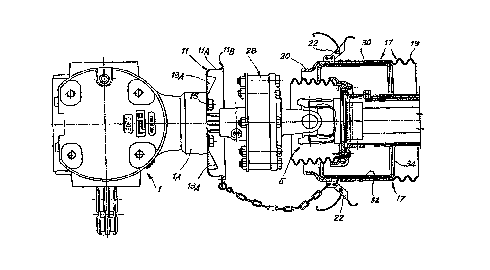Some of the information on this Web page has been provided by external sources. The Government of Canada is not responsible for the accuracy, reliability or currency of the information supplied by external sources. Users wishing to rely upon this information should consult directly with the source of the information. Content provided by external sources is not subject to official languages, privacy and accessibility requirements.
Any discrepancies in the text and image of the Claims and Abstract are due to differing posting times. Text of the Claims and Abstract are posted:
| (12) Patent Application: | (11) CA 2263209 |
|---|---|
| (54) English Title: | PROTECTIVE SECOND BOOT FOR CONNECTABLE COMPONENTS, FOR PREVENTING ACCIDENTS INVOLVING DRIVELINES INCORPORATING SHAFTS WITH UNIVERSAL JOINTS OR THE LIKE |
| (54) French Title: | SECOND CAPOT DE PROTECTION POUR COMPOSANTS POUVANT ETRE ACCOUPLES, CONCU POUR EMPECHER LES ACCIDENTS IMPLIQUANT LES CHAINES CINEMATIQUES DOTEES D'ARBRES A JOINTS UNIVERSELS OU SIMILAIRE |
| Status: | Deemed Abandoned and Beyond the Period of Reinstatement - Pending Response to Notice of Disregarded Communication |
| (51) International Patent Classification (IPC): |
|
|---|---|
| (72) Inventors : |
|
| (73) Owners : |
|
| (71) Applicants : |
|
| (74) Agent: | SMART & BIGGAR LP |
| (74) Associate agent: | |
| (45) Issued: | |
| (86) PCT Filing Date: | 1997-07-28 |
| (87) Open to Public Inspection: | 1998-02-19 |
| Availability of licence: | N/A |
| Dedicated to the Public: | N/A |
| (25) Language of filing: | English |
| Patent Cooperation Treaty (PCT): | Yes |
|---|---|
| (86) PCT Filing Number: | PCT/IT1997/000189 |
| (87) International Publication Number: | IT1997000189 |
| (85) National Entry: | 1999-02-12 |
| (30) Application Priority Data: | ||||||
|---|---|---|---|---|---|---|
|
The second boot that protects parts adjacent to a fixed box from which there
projects a rotating hub that is to be connected to a driveline (with the
possible presence of a friction clutch or of a torque limiting means)
comprises - attached to the fixed box (1) - a disc (11) with a peripheral edge
(11A) for engagement and fastening; and a sleeve (17) that can be engaged
inside the edge (11A-11B) of said disc (11), with fastening clips (22) capable
of being clipped to and unclipped from said edge (11A-11B). Said sleeve (17)
may include protective layers around the parts which it encloses.
Le second capot qui protège des parties adjacentes à une boîte fixe depuis laquelle un moyeu rotatif à relier à une chaîne cinématique (un embrayage à friction ou un moyen limiteur de couple étant éventuellement présent) comporte: fixée à la boîte fixe (1), un disque (11) dont le bord périphérique (11A) permet l'emboîtement et la fixation; un manchon (17) qui peut s'engager dans le bord (11A-11B) dudit disque (11), des moyens d'attache (22) pouvant être fixés sur ledit bord (11A-11B) et en être enlevés. Ledit manchon (17) peut comporter des couches de protection autour des parties qu'il entoure.
Note: Claims are shown in the official language in which they were submitted.
Note: Descriptions are shown in the official language in which they were submitted.

2024-08-01:As part of the Next Generation Patents (NGP) transition, the Canadian Patents Database (CPD) now contains a more detailed Event History, which replicates the Event Log of our new back-office solution.
Please note that "Inactive:" events refers to events no longer in use in our new back-office solution.
For a clearer understanding of the status of the application/patent presented on this page, the site Disclaimer , as well as the definitions for Patent , Event History , Maintenance Fee and Payment History should be consulted.
| Description | Date |
|---|---|
| Application Not Reinstated by Deadline | 2003-07-28 |
| Time Limit for Reversal Expired | 2003-07-28 |
| Inactive: Abandon-RFE+Late fee unpaid-Correspondence sent | 2002-07-29 |
| Deemed Abandoned - Failure to Respond to Maintenance Fee Notice | 2002-07-29 |
| Classification Modified | 1999-04-12 |
| Inactive: First IPC assigned | 1999-04-12 |
| Inactive: IPC assigned | 1999-04-12 |
| Inactive: IPC assigned | 1999-04-12 |
| Inactive: IPC assigned | 1999-04-12 |
| Inactive: Notice - National entry - No RFE | 1999-03-30 |
| Application Received - PCT | 1999-03-26 |
| Application Published (Open to Public Inspection) | 1998-02-19 |
| Abandonment Date | Reason | Reinstatement Date |
|---|---|---|
| 2002-07-29 |
The last payment was received on 2001-06-26
Note : If the full payment has not been received on or before the date indicated, a further fee may be required which may be one of the following
Patent fees are adjusted on the 1st of January every year. The amounts above are the current amounts if received by December 31 of the current year.
Please refer to the CIPO
Patent Fees
web page to see all current fee amounts.
| Fee Type | Anniversary Year | Due Date | Paid Date |
|---|---|---|---|
| Basic national fee - standard | 1999-02-12 | ||
| MF (application, 2nd anniv.) - standard | 02 | 1999-07-28 | 1999-07-02 |
| MF (application, 3rd anniv.) - standard | 03 | 2000-07-28 | 2000-06-30 |
| MF (application, 4th anniv.) - standard | 04 | 2001-07-30 | 2001-06-26 |
Note: Records showing the ownership history in alphabetical order.
| Current Owners on Record |
|---|
| EDI BONDIOLI |
| Past Owners on Record |
|---|
| None |